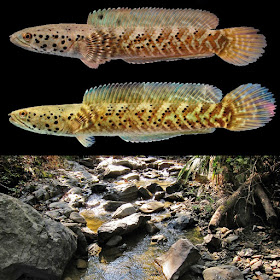 |
| Channa stiktos
Lalramliana, Knight, Lalhlimpuia & Singh, 2018
|
Abstract
Channa stiktos, a new species of snakehead fish, is described from the River Kaladan and its tributaries, Mizoram, North Eastern India based on comparison of morphological and molecular features with closely related species. Channa stiktos is morphologically similar to C. ornatipinnis described from the Rakhine State of Myanmar, however, differs from it in having black spots on dorsal and ventral sides of the head (vs. no spots on dorsal and ventral sides of the head, but rather spots restricted to the post-orbital lateral region of the head), and lacking dark spot on the anal fin of juveniles (vs. presence of series of upto 10 dark spots). The molecular analysis, based on cytochrome c oxidase subunit I (COI) sequences, shows that C. stiktos is distinct from other close Channa species, except clade 3 of C. ornatipinnis, available in the GenBank (interspecies distance ranges from 8.24–25.33%). Channa stiktos clustered cohesively with clade 3 of C. ornatipinnis (only 1.43% genetic distance) indicating that they are conspecific. The genetic distance between Channa stiktos and C. ornatipinnis (from the type locality and another locality in the Ayeyarwaddy basin) are 8.24–8.59%, and between C. stiktos and C. pulchra is 12.92%, supporting the conclusion that they are different species.
Key words Channa ornatipinnis, C. pulchra, COI, Taxonomy, Freshwater fish, River Kaladan, Indo-Burma Biodiversity hotspot.
 |
Fig. 2. Channa stiktos sp. nov. live specimens from Tiau River, Mizoram, India. A: ca. 35 mm SL; B: ca. 90 mm SL; C: ca. 110 mm SL; D: ca. 120 mm SL.
|
Channa stiktos sp. nov.
Diagnosis. Channa stiktos is distinguished from all other species of Channa, except C. ornatipinnis, C. pulchra, C. pardalis, C. melanostigma and C. stewartii, by a unique colour pattern consisting of numerous large, black spots on the head and the body. Channa stiktos is distinguished from C. ornatipinnis in having black spots on dorsal and ventral sides of the head (vs. no spots on dorsal and ventral sides of the head, but rather spots restricted to the post-orbital lateral region of the head), and absence of dark spot on the anal fin of juveniles (vs. presence of series of up to 10 dark spots).
It can be distinguished from Channa pulchra in having black spots on the body well distributed above and below the lateral line (vs. sparsely distributed or absent on the body below the lateral line); from C. pardalis in having black spots all over the head (vs. spots restricted to post-orbital region of the head); and from both C. stewartii and C. melanostigma in having well defined black spots on the head (vs. spots on the head absent, and restricted to the body).
Etymology. The specific epithet ‘stiktos’ meaning ‘spotted’ in Greek, referring to the numerous conspicuous spots present on the body. It is use as an adjective.
Distribution and habitat. Channa stiktos was collected from the Ianava, Niawh and Tiau Rivers of the Kaladan River drainage, Mizoram, North Eastern India (Fig. 3). The streams were clear, slow flowing with cobble substrate and no aquatic vegetation (Fig. 4).
Lalramliana, John Daniel Marcus Knight, Denis Van Lalhlimpuia and Mahender Singh. 2018. Integrative Taxonomy Reveals A New Species of Snakehead Fish, Channa stiktos (Teleostei: Channidae), from Mizoram, North Eastern India. VERTEBRATE ZOOLOGY. 68(2).

